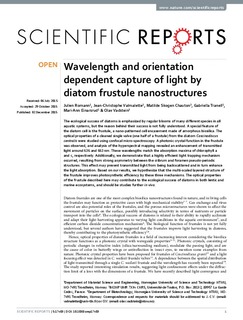| dc.contributor.author | Romann, Julien Clement | |
| dc.contributor.author | Valmalette, Jean-Christophe | |
| dc.contributor.author | Chauton, Matilde Skogen | |
| dc.contributor.author | Tranell, Gabriella | |
| dc.contributor.author | Einarsrud, Mari-Ann | |
| dc.contributor.author | Vadstein, Olav | |
| dc.date.accessioned | 2016-03-03T08:16:52Z | |
| dc.date.accessioned | 2016-03-08T14:59:16Z | |
| dc.date.available | 2016-03-03T08:16:52Z | |
| dc.date.available | 2016-03-08T14:59:16Z | |
| dc.date.issued | 2015 | |
| dc.identifier.citation | Scientific Reports 2015, 5:17403 | nb_NO |
| dc.identifier.issn | 2045-2322 | |
| dc.identifier.uri | http://hdl.handle.net/11250/2381831 | |
| dc.description.abstract | The ecological success of diatoms is emphasized by regular blooms of many different species in all
aquatic systems, but the reason behind their success is not fully understood. A special feature of
the diatom cell is the frustule, a nano-patterned cell encasement made of amorphous biosilica. The
optical properties of a cleaned single valve (one half of a frustule) from the diatom Coscinodiscus
centraliswere studied using confocal micro-spectroscopy. A photonic crystal function in the frustule
was observed, and analysis of the hyperspectral mapping revealed an enhancement of transmitted
light around 636 and 663 nm. These wavelengths match the absorption maxima of chlorophyll a
and c, respectively. Additionally, we demonstrate that a highly efficient light trapping mechanism
occurred, resulting from strong asymmetry between the cribrum and foramen pseudo-periodic
structures. This effect may prevent transmitted light from being backscattered and in turn enhance
the light absorption. Based on our results, we hypothesize that the multi-scaled layered structure of
the frustule improves photosynthetic efficiency by these three mechanisms. The optical properties
of the frustule described here may contribute to the ecological success of diatoms in both lentic and
marine ecosystems, and should be studies further in vivo. | nb_NO |
| dc.language.iso | eng | nb_NO |
| dc.publisher | Nature Publishing Group | nb_NO |
| dc.title | Wavelength and orientation dependent capture of light by diatom frustule nanostructures | nb_NO |
| dc.type | Peer reviewed | nb_NO |
| dc.type | Journal article | en_GB |
| dc.date.updated | 2016-03-03T08:16:52Z | |
| dc.source.journal | Scientific Reports | nb_NO |
| dc.identifier.doi | 10.1038/srep17403 | |
| dc.identifier.cristin | 1299259 | |
| dc.description.localcode | This work is licensed under a Creative Commons Attribution 4.0 International License. The images or other third party material in this article are included in the article’s Creative Commons license, unless indicated otherwise in the credit line; if the material is not included under the Creative Commons license, users will need to obtain permission from the license holder to reproduce the material. To view a copy of this license, visit http://creativecommons.org/licenses/by/4.0/ | nb_NO |
